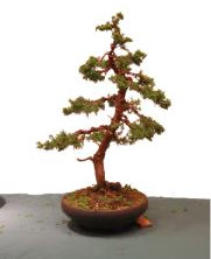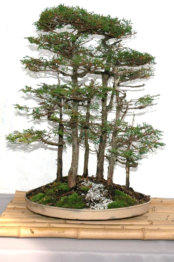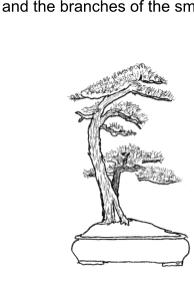Formal upright or Chokkan - Straight, upright, tapering trunk. Branches progress regularly from the
thickest and broadest at the bottom to the finest and shortest at the top.
Informal upright or takichi - Trunk has visible curves, but the apex of the tree is located directly above
the trunk's entry into the soil line.
Extreme Informal or Miyogi - Trunk has exaggerated curves and often lots of deadwood.
Slanting or Shakan - Trunk is straight like that of a formal upright but the apex of the bonsai is located to
the left or right of the root base.
Cascade or Kengai - Bottom of a cascade style falls below the base of the pot.
Semi-cascade or Han-kengai - Bottom of the tree extends beneath level of the lip of the bonsai pot but
not below the base of the pot.
Exposed-root or Neagari - Roots of the tree are exposed as extensions of the trunk, free from soil. This
type of tree would be seen along a stream where the soil is slowly eroded from under the tree.
Twin-trunk, two-trunk or Sokan - Two trunks rise from a single set of roots. Generally one trunk will be
larger than the other and they are often called mother/daughter. Generally, the smaller trunk will be behind
and the branches of the smaller trunk start lower but complete those of the bigger tree.
Forest or Yose-ue - Planting of many trees, typically an odd number unless too many to count easily, in a
bonsai pot or more often, on a slab of stone.
Literati or Bunjingi - A bare trunk line, with few branches typically near the apex of a long, often contorted
trunk.
Broom or Hokidachi -Tree with extensive, fine branching. Trunk is straight and upright and branches out
in all directions about 1/3 of the way up the entire height of the tree forming a ball-shaped crown.
Windswept or Fukinagashi - A slant style where all of the branches are on one side of the tree as if they
had been blown there by a strong persistent wind along a coast.


















Tree Styles

Brandywine Bonsai Society is an educational organization and as a result, the material in this site may be copied for
educational purposes. If large portions are copied, we would appreciate attribution. We welcome links to this site.





Formal upright or Chokkan - Straight, upright, tapering trunk.
Branches progress regularly from the thickest and broadest at the
bottom to the finest and shortest at the top.
Informal upright or takichi - Trunk has visible curves, but the
apex of the tree is located directly above the trunk's entry into the
soil line.
Extreme Informal or Miyogi - Trunk has exaggerated curves
and often lots of deadwood.
Slanting or Shakan - Trunk is straight like that of a formal upright
but the apex of the bonsai is located to the left or right of the root
base.
Cascade or Kengai - Bottom of a cascade style falls below the
base of the pot.
Semi-cascade or Han-kengai - Bottom of the tree extends
beneath level of the lip of the bonsai pot but not below the base of
the pot.
Exposed-root or Neagari - Roots of the tree are exposed as
extensions of the trunk, free from soil. This type of tree would be
seen along a stream where the soil is slowly eroded from under
the tree.
Twin-trunk, two-trunk or Sokan - Two trunks rise from a single
set of roots. Generally one trunk will be larger than the other and
they are often called mother/daughter. Generally, the smaller
trunk will be behind and the branches of the smaller trunk start
lower but complete those of the bigger tree.
Forest or Yose-ue - Planting of many trees, typically an odd
number unless too many to count easily, in a bonsai pot or more
often, on a slab of stone.
Literati or Bunjingi - A bare trunk line, with few branches typically
near the apex of a long, often contorted trunk.
Broom or Hokidachi -Tree with extensive, fine branching. Trunk
is straight and upright and branches out in all directions about 1/3
of the way up the entire height of the tree forming a ball-shaped
crown.
Windswept or Fukinagashi - A slant style where all of the
branches are on one side of the tree as if they had been blown
there by a strong persistent wind along a coast.

















Tree Styles

Brandywine Bonsai Society is an educational organization and as a result, the material in this site may be copied for
educational purposes. If large portions are copied, we would appreciate attribution. We welcome links to this site.














































